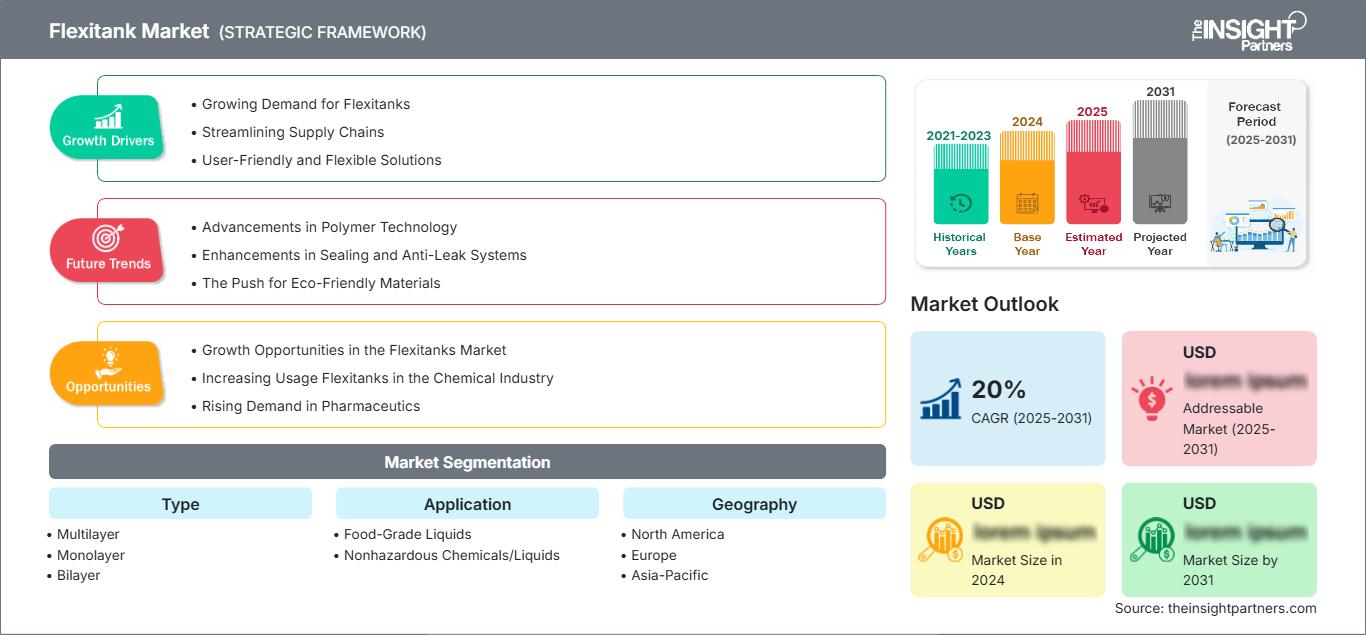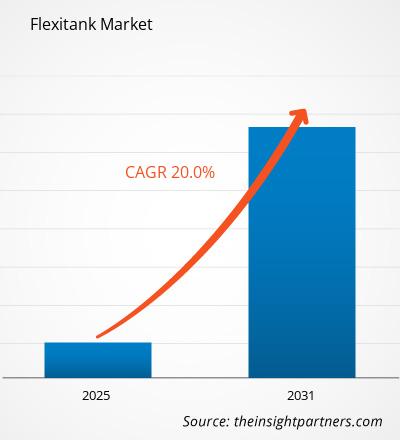Si prevede che il mercato Flexitank raggiungerà 1,35 miliardi di dollari entro il 2031. Si prevede che il mercato registrerà un CAGR del 15,2% nel periodo 2025-2031.
Il rapporto presenta un'analisi basata sulla tipologia (multistrato, monostrato e bistrato). Il rapporto è segmentato per applicazione (liquidi per uso alimentare, prodotti chimici/liquidi non pericolosi e altri). L'analisi globale è ulteriormente suddivisa a livello regionale e per i principali paesi. Le dimensioni del mercato e le previsioni a livello globale, regionale e nazionale per tutti i principali segmenti di mercato sono coperte dall'ambito di applicazione. Il rapporto fornisce il valore in dollari USA per l'analisi e i segmenti sopra indicati. Il rapporto fornisce statistiche chiave sullo stato del mercato dei principali attori e offre tendenze e opportunità di mercato.
Scopo del rapporto
Il rapporto Flexitank Market di The Insight Partners mira a descrivere il panorama attuale e la crescita futura, i principali fattori trainanti, le sfide e le opportunità. Ciò fornirà approfondimenti a vari stakeholder aziendali, come:
- Fornitori/produttori di tecnologia: per comprendere le dinamiche di mercato in evoluzione e conoscere le potenziali opportunità di crescita, consentendo loro di prendere decisioni strategiche informate.
- Investitori: per condurre un'analisi completa delle tendenze in merito al tasso di crescita del mercato, alle proiezioni finanziarie del mercato e alle opportunità esistenti lungo la catena del valore.
- Enti di regolamentazione: per regolamentare le politiche e le attività di controllo sul mercato con l'obiettivo di ridurre al minimo gli abusi, preservare la fiducia degli investitori e sostenere l'integrità e la stabilità del mercato.
Tipo di segmentazione del mercato Flexitank
- Multistrato
- Monostrato
- Doppio strato
Applicazione
- Liquidi per uso alimentare
- Prodotti chimici/liquidi non pericolosi
Potrai personalizzare gratuitamente qualsiasi rapporto, comprese parti di questo rapporto, o analisi a livello di paese, pacchetto dati Excel, oltre a usufruire di grandi offerte e sconti per start-up e università
Mercato Flexitank: Approfondimenti strategici

-
Ottieni le principali tendenze chiave del mercato di questo rapporto.Questo campione GRATUITO includerà l'analisi dei dati, che vanno dalle tendenze di mercato alle stime e alle previsioni.
Fattori di crescita del mercato dei Flexitank
- Crescente domanda di Flexitank: i Flexitank sono molto richiesti come mezzo conveniente per spedire liquidi sfusi in modo economicamente vantaggioso. La crescente necessità di un trasporto efficiente di merci liquide sta trainando la domanda all'interno del mercato. L'industria alimentare e delle bevande, chimica e farmaceutica sta utilizzando i Flexitank poiché ottimizzano lo spazio all'interno dei container.
- Snellimento delle catene di approvvigionamento: con l'espansione del commercio internazionale, le aziende avranno bisogno di soluzioni innovative per semplificare i processi della loro catena di approvvigionamento. I Flexitank consentono di movimentare maggiori volumi di liquidi in container tradizionali. Questa efficienza consente di risparmiare sui costi di spedizione e contribuisce a ridurre il degrado ambientale, fattori che potrebbero rientrare negli obiettivi di sostenibilità che la maggior parte delle organizzazioni sta perseguendo.
- Soluzioni flessibili e intuitive: inoltre, i Flexitank sono diventati popolari perché sono facili da usare e flessibili. Sono più veloci da assemblare e richiedono meno pulizia rispetto alle cisterne tradizionali. La flessibilità, in un mercato in rapida evoluzione come quello attuale, è fondamentale sia in termini di tempo che di risorse. Le aziende puntano all'efficienza operativa e quindi continuano a ordinare queste soluzioni.
Tendenze future del mercato dei Flexitank
- Progressi nella tecnologia dei polimeri: le innovazioni nella tecnologia dei polimeri, unite alle nuove scoperte nella scienza dei materiali che potrebbero portare a una nuova era di materiali più robusti, leggeri ma allo stesso tempo più affidabili e durevoli, hanno portato i consumatori a godere di maggiore sicurezza e affidabilità associate ai Flexitank.
- Miglioramenti nei sistemi di tenuta e anti-perdita: nuovi design, inclusi sistemi di tenuta e anti-perdita migliorati, stanno contribuendo alla crescita del mercato. Queste caratteristiche evitano contaminazioni e perdite, che sono state la principale fonte di preoccupazione per molti produttori e fornitori di servizi logistici. Le aziende stanno ora optando per metodi di trasporto sicuri e protetti e gli aggiornamenti tecnologici in tali parametri stanno diventando sempre più essenziali per soddisfare gli standard industriali.
- La spinta verso materiali ecocompatibili: inoltre, i materiali ecocompatibili rappresentano un'area di ricerca in forte crescita. Con l'attenzione rivolta al rispetto dell'ambiente, i produttori di flexitank esplorano materiali biodegradabili o riciclabili, in quanto possono ridurre l'esposizione ai danni ambientali e attrarre aziende attente all'ambiente per sostenere una clientela ecosostenibile.
Opportunità di mercato per i flexitank
- Opportunità di crescita nel mercato dei flexitank: l'espansione in altri settori come quello chimico, farmaceutico e cosmetico offre grandi opportunità di crescita per il mercato dei flexitank, non più limitato al settore alimentare e delle bevande, dove la maggior parte del suo utilizzo iniziale riguardava il trasporto di liquidi.
- Crescente utilizzo dei flexitank nell'industria chimica: nell'industria chimica, il trasporto di liquidi non pericolosi in flexitank si è recentemente affermato come pratica comune, offrendo un'alternativa economica alle tradizionali cisterne. I Flexitank sono grandi tubi prefabbricati, realizzati in materiale flessibile plastico/PVC. Possono trasportare grandi quantità di prodotto mantenendone l'integrità. I produttori che necessitano di una soluzione logistica estremamente efficiente li trovano interessanti. Questa potrebbe essere una tendenza positiva per applicazioni che comprendono una gamma molto più ampia di merci liquide.
- Crescente domanda nel settore farmaceutico: anche il settore farmaceutico sta guadagnando valore grazie all'uso dei Flexitank per il trasporto di grandi volumi di liquidi, inclusi vaccini e altre forniture mediche. Oltre ai vantaggi dell'uso dei Flexitank, come la limitazione dei rischi di contaminazione e la garanzia della qualità del prodotto, emerge la necessità di metodi di trasporto sicuri e affidabili. L'accettazione dei prodotti farmaceutici sta crescendo con questi sviluppi attuali, favorendo la domanda futura.
Mercato dei serbatoi flessibili
Le tendenze regionali e i fattori che influenzano il mercato Flexitank durante il periodo di previsione sono stati ampiamente spiegati dagli analisti di The Insight Partners. Questa sezione illustra anche i segmenti e la geografia del mercato della gestione delle malattie del ritmo cardiaco in Nord America, Europa, Asia-Pacifico, Medio Oriente e Africa, America meridionale e centrale.
Ambito del rapporto di mercato Flexitank
| Attributo del rapporto | Dettagli |
|---|---|
| Dimensioni del mercato in 2024 | US$ XX Billion |
| Dimensioni del mercato per 2031 | US$ 1.35 Billion |
| CAGR globale (2025 - 2031) | 15.2% |
| Dati storici | 2021-2023 |
| Periodo di previsione | 2025-2031 |
| Segmenti coperti |
By Tipo
|
| Regioni e paesi coperti |
Nord America
|
| Leader di mercato e profili aziendali chiave |
|
Densità degli operatori del mercato Flexitank: comprendere il suo impatto sulle dinamiche aziendali
Il mercato Flexitank è in rapida crescita, trainato dalla crescente domanda degli utenti finali, dovuta a fattori quali l'evoluzione delle preferenze dei consumatori, i progressi tecnologici e una maggiore consapevolezza dei vantaggi del prodotto. Con l'aumento della domanda, le aziende stanno ampliando la propria offerta, innovando per soddisfare le esigenze dei consumatori e sfruttando le tendenze emergenti, alimentando ulteriormente la crescita del mercato.

- Ottieni il Mercato Flexitank Panoramica dei principali attori chiave
Punti di forza
- Copertura completa: il rapporto analizza in modo esaustivo prodotti, servizi, tipologie e utenti finali del mercato Flexitank, offrendo una panoramica olistica.
- Analisi degli esperti: il rapporto è redatto sulla base della conoscenza approfondita di esperti e analisti del settore.
- Informazioni aggiornate: il rapporto garantisce la pertinenza aziendale grazie alla copertura di informazioni e dati recenti.
- Opzioni di personalizzazione: questo rapporto può essere personalizzato per soddisfare le esigenze specifiche del cliente e adattarsi in modo appropriato alle strategie aziendali.
Il rapporto di ricerca sul mercato Flexitank può quindi aiutare a guidare il percorso di decodificazione e comprensione dello scenario del settore e delle prospettive di crescita. Sebbene possano esserci alcune valide preoccupazioni, i vantaggi complessivi di questo rapporto tendono a superare gli svantaggi.
- Analisi storica (2 anni), anno base, previsione (7 anni) con CAGR
- Analisi PEST e SWOT
- Valore/volume delle dimensioni del mercato - Globale, Regionale, Nazionale
- Industria e panorama competitivo
- Set di dati Excel
Report recenti
Testimonianze
Motivo dell'acquisto
- Processo decisionale informato
- Comprensione delle dinamiche di mercato
- Analisi competitiva
- Analisi dei clienti
- Previsioni di mercato
- Mitigazione del rischio
- Pianificazione strategica
- Giustificazione degli investimenti
- Identificazione dei mercati emergenti
- Miglioramento delle strategie di marketing
- Aumento dell'efficienza operativa
- Allineamento alle tendenze normative






















 Ottieni un campione gratuito per - Mercato Flexitank
Ottieni un campione gratuito per - Mercato Flexitank